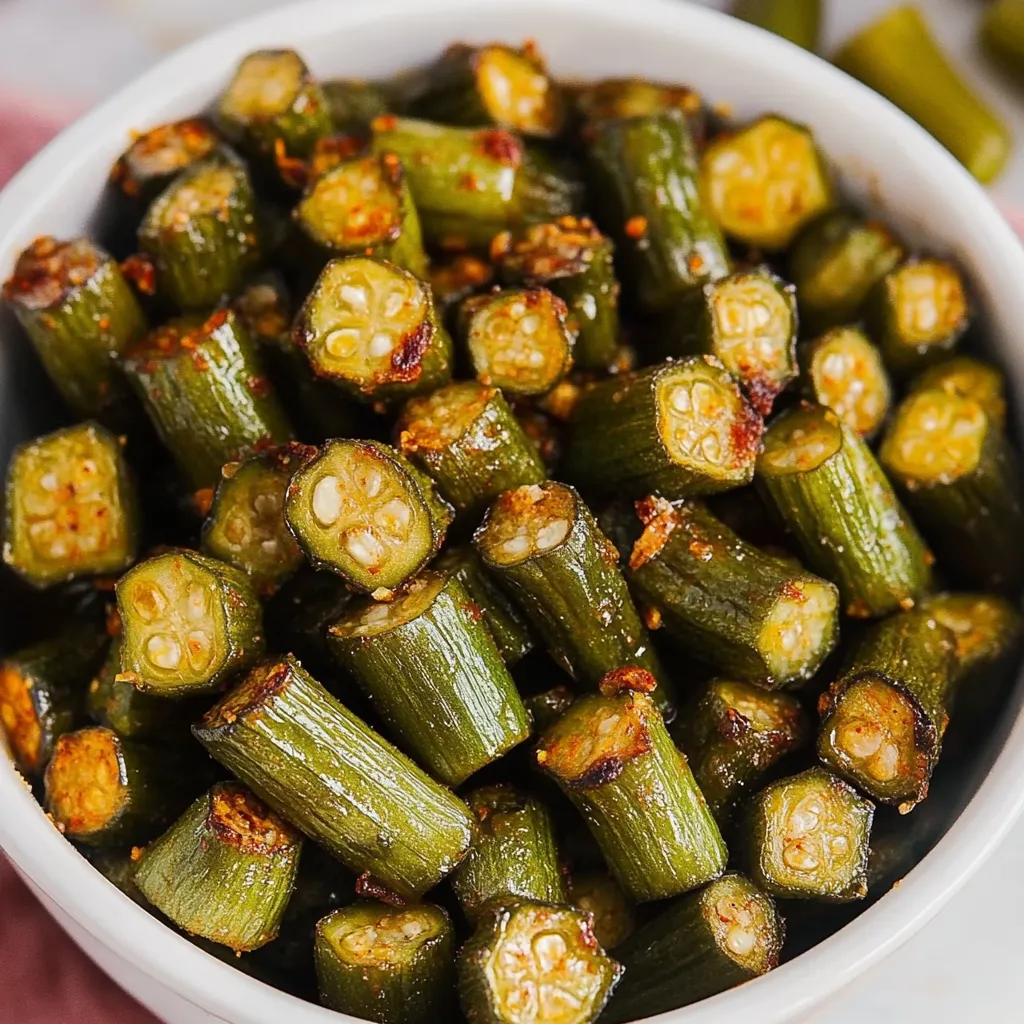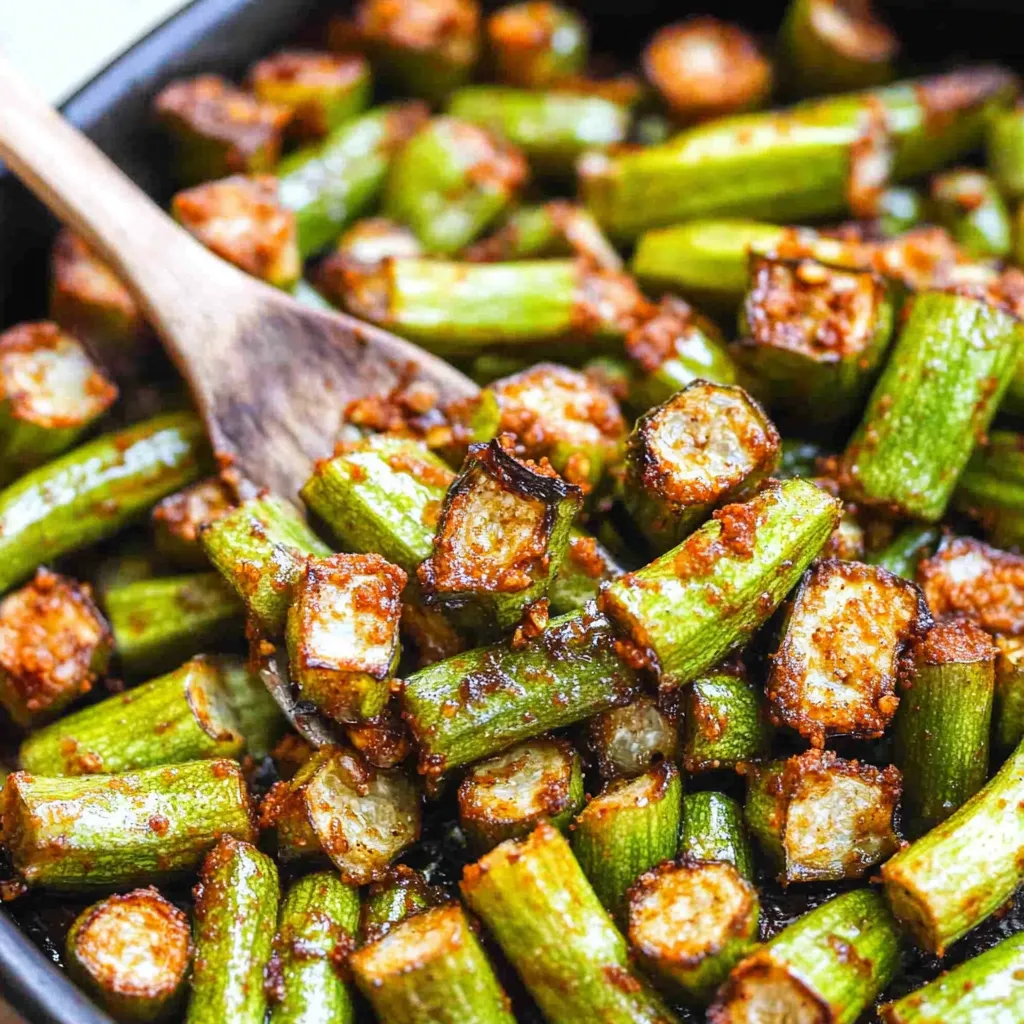 Pin it
Pin it
This spectacular garlic roasted okra completely transforms one of the most misunderstood vegetables into crispy, golden perfection that rivals french fries in addictive appeal while delivering superior nutrition and flavor complexity. The genius of this recipe lies in its high-heat roasting technique combined with strategic cutting that eliminates okra's notorious sliminess while creating tender interiors and beautifully caramelized edges enhanced by aromatic garlic powder and smoky paprika. Unlike traditional okra preparations that often emphasize the vegetable's challenging texture, this method showcases okra's naturally mild flavor and impressive nutritional profile while creating the kind of irresistible side dish that converts even the most skeptical eaters into okra enthusiasts.
I developed this technique when determined to find a preparation that would showcase okra's potential rather than apologize for its texture, and the breakthrough came when I realized that proper cutting combined with high-heat roasting creates the crispy-tender contrast that makes vegetables irresistible.
Essential Ingredients and Selection Tips
- Fresh okra pods: Choose bright green, smooth pods under 5 inches long with no brown spots or dry ends; smaller pods have better texture and fewer tough seeds
- Quality plant butter: Provides rich flavor and promotes even browning; olive oil can substitute but won't create the same depth of flavor
- Garlic powder over fresh: Powder distributes evenly and won't burn at high temperatures like fresh garlic would during roasting
- Sweet paprika: Adds color and mild pepper flavor without heat; smoked paprika can substitute for deeper flavor complexity
- Proper salt: Fine sea salt or kosher salt distributes better than coarse varieties for even seasoning coverage
The secret to perfect results is proper okra selection, strategic cutting, and maintaining high oven temperature for optimal texture development.
Detailed Step-by-Step Instructions
- Step 1: Select and prepare okra:
- Choose firm, bright green pods under 5 inches long, rinse thoroughly, and pat completely dry with paper towels.
- Step 2: Trim properly:
- Remove stem ends with sharp knife, then cut okra into ½ to ¾-inch pieces to expose interior and prevent sliminess.
- Step 3: Prepare seasoning blend:
- In small bowl, combine garlic powder, paprika, and salt, mixing thoroughly for even distribution.
- Step 4: Toss with fat:
- Place cut okra in medium bowl, add melted plant butter, and toss to coat all pieces evenly.
- Step 5: Season evenly:
- Sprinkle seasoning mixture over buttered okra and mix well to ensure every piece is coated.
- Step 6: Arrange for roasting:
- Transfer seasoned okra to parchment-lined baking sheet, spreading in single layer without overcrowding.
- Step 7: Roast at high heat:
- Bake at 450°F for 15 minutes until edges are golden brown and pieces are tender when pierced.
- Step 8: Check for doneness:
- Okra should be caramelized on edges with tender interiors; extend cooking time if needed for proper browning.
- Step 9: Finish and serve:
- Remove from oven and serve immediately while hot and crispy, optionally with lemon juice for brightness.
- Step 10: Store properly:
- Keep leftovers refrigerated up to 5 days and reheat in oven to restore crispiness rather than microwaving.
 Pin it
Pin it
The most important technique is cutting okra properly and maintaining high heat throughout roasting for optimal texture development.
This garlic roasted okra has become my favorite example of how proper technique can completely transform challenging ingredients into crowd-pleasing dishes.
Understanding Okra Biology and Slime Prevention
Okra's characteristic mucilage forms when cell walls break down and release polysaccharides that become gel-like when exposed to moisture. Strategic cutting exposes these compounds to dry heat, which evaporates moisture quickly while creating caramelization that masks any remaining texture issues through proper browning reactions.
Temperature Science and Texture Development
The 450°F roasting temperature is crucial for achieving proper texture contrast. This high heat creates rapid moisture evaporation from cut surfaces while promoting Maillard browning that develops complex flavors and appealing color. Lower temperatures would steam the okra rather than roast it, potentially creating the undesirable slimy texture.
Seasoning Distribution and Flavor Balance
Garlic powder works better than fresh garlic at high temperatures because it won't burn and become bitter. The paprika adds both color and mild pepper flavor while the salt enhances natural vegetable flavors. Pre-mixing seasonings ensures even distribution and prevents hot spots of concentrated flavor.
Fat Selection and Browning Enhancement
Plant butter provides both flavor and functional benefits, creating better browning through milk proteins and sugars while keeping okra moist during the high-heat cooking process. The fat also helps seasonings adhere properly and prevents vegetables from drying out before proper caramelization occurs.
Cutting Technique and Moisture Management
Cutting okra into uniform pieces ensures even cooking while exposing interior surfaces to direct heat. This technique allows moisture to escape quickly while maximizing surface area for browning reactions. Consistent sizing also prevents some pieces from overcooking while others remain undercooked.
This garlic roasted okra has taught me that some of the most rewarding cooking experiences come from taking ingredients that intimidate people and finding techniques that showcase their best qualities while eliminating problematic aspects. Every time I make it, I'm reminded that proper technique often matters more than expensive ingredients when creating memorable dishes, proving that simple preparations executed well can transform humble vegetables into something extraordinary that changes people's minds about ingredients they thought they didn't like, opening up new possibilities for both nutrition and flavor in everyday cooking.
Frequently Asked Questions
- → How do I keep roasted okra from getting slimy?
- Make sure to dry the okra completely after washing and roast at high heat. The 450°F temperature helps create a crispy exterior.
- → Can I use frozen okra for this recipe?
- Fresh okra works best, but you can use frozen. Just thaw it completely and pat very dry before seasoning and roasting.
- → What can I serve with roasted okra?
- This pairs well with grilled chicken, fish, rice dishes, or as part of a vegetable medley. It's great as a healthy snack too.
- → How long does leftover roasted okra last?
- Store in the fridge for 3-5 days in an airtight container. Reheat in the oven to get the crispiness back.
- → Can I make this spicier?
- Yes! Add a pinch of cayenne pepper or try using Berbere seasoning instead of paprika for more complex heat and flavor.
- → Do I need to soak okra before roasting?
- No soaking needed. Just rinse, dry thoroughly, trim the stems, and cut into pieces before seasoning.
